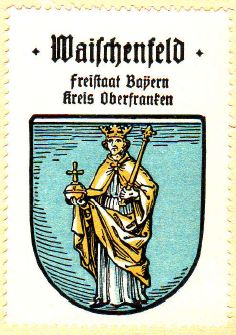Waischenfeld
This page is part of the German heraldry portal Deutsche Wappensammlung |
Heraldry of the World |
|
German heraldry:
|
Selected collector's items from Germany:
|
WAISCHENFELD
State : Bayern
District (Kreis) : Bayreuth (until 1973 Ebermannstadt)
Additions : 1971 Gösseldorf, Seelig; 1972 Hannberg, Langenloh, Nankendorf (partly), Rabeneck (1865 Eichenbirkig, Köttweinsdorf); 1977 Breitenlesau (partly)
Official blazon
- (de) In Rot ein auf goldenem Boden stehender Kaiser mit pelzverbrämtem goldenen Mantel, blau gefütterter goldener Krone und blauen Schuhen, in der Rechten das goldene Zepter, in der Linken den Reichsapfel.
Origin/meaning
The arms were officially granted on April 12, 1951.
The arms are based on the oldest known seal of the city from 1565, but which probably was made in the 15th century. It is not known if older seals have existed. The first seal shows a sitting man, holding an orb and scepter, obviously a King or Emperor. In later seals the figure was shown standing, and in 1692 the figure was mentioned in the Bamberger Vasallentafel as Emperor Heinrich II of Bayern (King in 1002 and Emperor in 1014). Why he was taken as the symbol of the city is unknown; during his reign civic seals were not in use and arms were not adopted until the end of the 12th century.
The arms were used in the 19th century with a blue field, as shown below by Hupp in the 1920s. In 1951 the (historical) colours were restored.
| The arms by Hupp in the Kaffee Hag albums +/- 1925 |
Contact and Support
Partners:
Your logo here ?
Contact us
© since 1995, Heraldry of the World, Ralf Hartemink 
Index of the site
Literature : Stadler, 1964-1971, 8 volumes; Hupp, O: Kaffee Hag albums, 1920s













